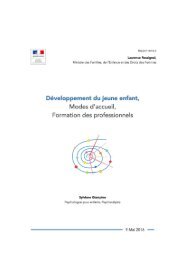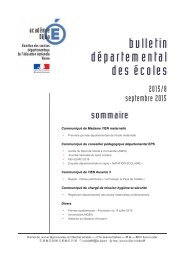agrl_innovations_in_ssa.pdf?utm_content=buffercb41d&utm_medium=social&utm_source=twitter
agrl_innovations_in_ssa.pdf?utm_content=buffercb41d&utm_medium=social&utm_source=twitter
agrl_innovations_in_ssa.pdf?utm_content=buffercb41d&utm_medium=social&utm_source=twitter
You also want an ePaper? Increase the reach of your titles
YUMPU automatically turns print PDFs into web optimized ePapers that Google loves.
large-scale farmers but also for smallholder farmers who prepare their land by hoe. Zimbabwe<br />
experiences with permanent plant<strong>in</strong>g bas<strong>in</strong>s were particularly valuable. A CFU was established<br />
with<strong>in</strong> ZNFU to spearhead the development and promotion of m<strong>in</strong>imum tillage low-<strong>in</strong>put CA<br />
technologies to Zambia’s smallholder farm<strong>in</strong>g community. From 1996 until 2006, CFU tested a<br />
range of CA technologies at GART research stations and through a series of on-farm trials. With<br />
modest fund<strong>in</strong>g from a series of donors <strong>in</strong>clud<strong>in</strong>g EU, NORAD, SIDA and F<strong>in</strong>land’s Government<br />
as well as Lonrho Cotton Company (subsequently purchased by Dunavant) the CFU moved<br />
to develop guidel<strong>in</strong>es for Zambia. Emphasis was placed on test<strong>in</strong>g such additive low-<strong>in</strong>put<br />
technologies as crop bas<strong>in</strong>s, crop rotations, an ox-drawn ripper, and agroforestry <strong>in</strong>clud<strong>in</strong>g a<br />
legum<strong>in</strong>ous tree – Faidherbia albida.<br />
In 1999 the Zambian MoC&A endorsed the promotion of CA as national extension policy. CFU<br />
has cont<strong>in</strong>ued to be a champion for CA provid<strong>in</strong>g tra<strong>in</strong><strong>in</strong>g to Government, NGOs and the private<br />
sector (CFU, 2009). CFU has been strongly supported by ZNFU, who realised the necessity for<br />
commercial viability by l<strong>in</strong>k<strong>in</strong>g farmers with markets, reduc<strong>in</strong>g transport costs and improv<strong>in</strong>g<br />
extension to ensure CA was a viable proposition. At the same time GART, a jo<strong>in</strong>t venture<br />
between Government, ZNFU and the University of Zambia, undertook research to validate<br />
and improve CA practices. CFU has worked with a range of NGO extension partners <strong>in</strong>clud<strong>in</strong>g<br />
Africare, CARE, the Catholic Diocese of Monze and World Vision produc<strong>in</strong>g field manuals and<br />
radio broadcasts <strong>in</strong> different local languages’ to facilitate promotion activities (GART, 2009).<br />
CFU’s two key field partners were Dunavant Cotton Company and the Cooperative League<br />
of the USA (CLUSA). Dunavant engaged CFU to run tra<strong>in</strong><strong>in</strong>g programmes aimed at 10,000-<br />
plus cotton farmers through farmer associations and lead farmer trials and demonstrations.<br />
Similarly CLUSA promoted CA <strong>in</strong> tra<strong>in</strong><strong>in</strong>g and demonstrations for 8000-plus farmers <strong>in</strong> Southern<br />
and Central Prov<strong>in</strong>ces as well as requir<strong>in</strong>g all farmers to adopt CA as a condition for receiv<strong>in</strong>g<br />
group loans and market<strong>in</strong>g support<br />
In 2007 NORAD made a 5-year commitment to support scal<strong>in</strong>g up of hand hoe and ripper<br />
systems, part of which enabled CFU to <strong>in</strong>troduce a lead farmer-tra<strong>in</strong><strong>in</strong>g module. More recently,<br />
a National Conservation Agriculture Association of Zambia (CAAZ) was formed with support<br />
from a DFID funded <strong>in</strong>itiative, RIU–Zambia to help l<strong>in</strong>k stakeholders and support Government<br />
<strong>in</strong>itiatives to further scale up CA. Two complimentary Government programmes, CASPP and<br />
FSIRP, supported by FAO have been established, with a task force consider<strong>in</strong>g policy issues<br />
<strong>in</strong>clud<strong>in</strong>g subsidies, possible use of electronic vouchers, to encourage greater participation of<br />
the private sector and establish<strong>in</strong>g technical guidel<strong>in</strong>es for CA, build<strong>in</strong>g on the work of CFU.<br />
CA platforms have emerged at, district, national and regional levels that are enabl<strong>in</strong>g the faster<br />
scal<strong>in</strong>g up of CA practices.<br />
Achievements: Estimates of adoption <strong>in</strong>dicate that by 2001, between 20 and 60 thousand<br />
farmers were us<strong>in</strong>g CA. By 2003 studies confirmed that CA was f<strong>in</strong>ancially attractive, although<br />
effectiveness varied across crops and over time due to weather fluctuations, but that up to<br />
150,000 farmers were us<strong>in</strong>g CA (Haggblade and Hazell, 2010). By 2006, CFU estimated that<br />
175,000 farmers were practic<strong>in</strong>g CA on a portion of their land. Most studies of CA document<br />
significantly higher yields than conventional techniques – up to 100 percent more for maize<br />
and 50 percent more for cotton.<br />
The case studies: Southern Africa 61






